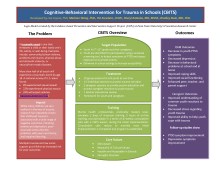
The Cognitive Behavioral Intervention for Trauma in Schools (CBITS) is a skill-based, group intervention that is aimed at relieving symptoms of Post Traumatic Stress Disorder (PTSD), depression, and general anxiety among children exposed to trauma. Children are provided with normalizing education about common reactions to stress and trauma, and learn skills such as relaxation, how to challenge and replace upsetting thoughts, and social problem solving. Children also work on processing traumatic memories and grief in both individual and group settings. The program consists of ten, 1-hour group sessions (6-8 children) usually conducted once a week in a school or mental health clinic setting. It also includes 1-3 individual sessions, 2 parent sessions, and a teacher education session.
Bounce Back is a cognitive-behavioral, skills-based, group intervention aimed at relieving symptoms of child traumatic stress, anxiety, depression, and functional impairment among elementary school children (ages 5-11) who have been exposed to traumatic events. Bounce Back is used most commonly for children who have experienced or witnessed community, family, or school violence, or who have been involved in natural disasters, accidents, physical abuse, neglect, or traumatic separation from a loved one due to death, incarceration, deportation, or child welfare detainment.
Program Type and Risk Level
CBITS/ Bounce Back
- Cognitive Behavioral Group
- School Based
- Intervention
Target Population
CBITS
- Ages 10-18
- Grades 5-12
- Groups of 4-8 youth
- Caregiver Session(s)
- Teacher Session
Bounce Back
- Ages 5-10
- Grades K-4th
- Groups of 4-8 youth